Well known for its massively important role in the Civil Rights Movement, being “The Peanut Capital of the World,” and even being home to the first Mardi Gras celebration in America, Alabama is a southern U.S. state with a rich history! That being said, it is also home to many wonderful, helpful native plants.
In this article, we will delve into just a few of those plants, why they’re important, and what you can do to help nourish them within your own landscape at home! Plus, we will also discuss some not-so-helpful plants (invasives!) that you are sure to find, and hopefully, remove!
The Importance of Native Plants
Whether you are a life-long gardener or a pandemic-era convert, we are pretty sure you’ve heard something about the all-important native plants! You may know that they’re good for the environment, but that may be all the information you’ve received. If that sounds like you, you may be struggling to figure out how you as a home gardener can help the environment with such little background on native plants, leading you instead to grab whatever annuals are being sold at your local garden center.
So, in this series, we are hoping to shed a bit of light on the subject of native plants! Native plants are species that occur naturally in a given area. They do not abide by our political borders, growing along mountain ranges and waterways that cross states, through meadows and forests of different continents!
But, above all, native plants provide many benefits to the landscapes in which they belong. As they belong there, they provide food and shelter for animals who are also native to the area. This helps increase biodiversity, or the diversity of species, which in turn helps maintain and nourish an ecosystem. Native plants also aid in protection against natural disasters, stabilizing the earth, blocking wind, and soaking up flood waters to name a few.
Natives Plants of Alabama
Of course, we can’t name every single native plant that calls Alabama home. So, instead, we have listed out a few natives from some of the main plant categories – perennials, shrubs, trees, and grasses – that we hope you will choose for your native landscape!
Perennials
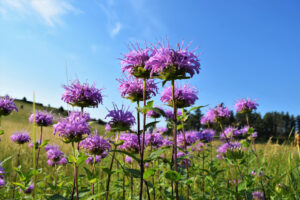
Southern Agrimony (Agrimonia parviflora)
A delicate perennial herb, southern agrimony is the most widespread of the genus, found in moist meadows and wetlands from the southern United States all the way to Canada. It has feather-like leaves and cute, small yellow flowers! Though this perennial is delicate in appearance, it can actually reach up to 6 feet tall in the best conditions. Traditionally, Native Americans would use this herb to treat stomach issues as well as sore throats!
Wild Bergamot (Monarda fistulosa)
Native to nearly every state in the U.S., wild bergamot is one of the most recognizable perennial flowers. Also known as bee balm, it is a favorite of pollinators from bees to butterflies! Not to be confused with the bergamot fruit that gives Earl Grey tea its distinct flavor, wild bergamot also has a history of medicinal use. When boiled, the leaves and flowers of wild bergamot have been known to aid with respiratory issues, as well as fever, sore throat, skin inflammation, and many other distressing symptoms.
Goatsbeard (Aruncus dioicus)
Slightly resembling astilbe, goatsbeard – or Bride’s Feathers as it’s sometimes called – is a pretty woodland perennial. Typically found in moist soils, this perennial has small white flowers and feather-like leaves. If you’re planning on using this in your landscape, you may want to purchase a fully grown specimen, as growing goatsbeard from seed could take some time. However, once your plant is established, they will grow wonderfully in shade or sun. Just like the previous perennials, goatsbeard was also used medicinally by Native Americans; the roots were boiled and used to help sore throats, rheumatism, and even blood diseases.
Shrubs
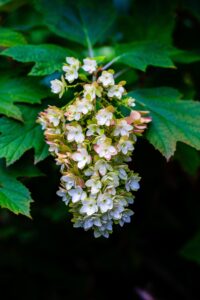
Oakleaf Hydrangea
Alabama’s state wildflower, oakleaf hydrangea is a stunning deciduous shrub. Though you may not typically think of a shrub as a wildflower, there is a pretty interesting story behind this one! The government of Alabama named the camellia as the state flower, but since it is not a native flower, they quickly made the oakleaf hydrangea a state symbol, as well! Found in almost every part of the state, the oakleaf hydrangea grows along mountainsides, in forests, along rivers, and it’s a great option for your own backyard!
Mountain Laurel (Kalmia latifolia)
One of the most popular and well known native shrubs, mountain laurel is great for forming dense, evergreen thickets! Its beautiful and unique light pink flowers are a showstopper as well as a pollinator-haven. However, do be careful with the leaves of mountain laurel; they are known to be toxic to livestock and it’s believed that the honey made from their nectar is also poisonous!
Alabama Azalea (Rhododendron alabamense)
Native to many areas in the southeastern U.S., the Alabama azalea is one of the most fragrant native azaleas, smelling to some like lemon ice! Displaying white, pink, and even sometimes yellow blooms, this native shrub tends to easily hybridize in the wild, leading to new versions all the time. The Alabama azalea is perfect for pollinator gardens as well as well-drained understories. Just make sure to avoid injecting in parts of this plant, as azaleas are known to be toxic to humans.
Trees
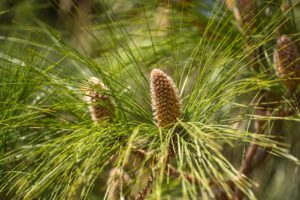
Longleaf Pine (Pinus palustris)
Alabama’s official state tree, the longleaf pine is native to much of the southeastern United States. If you were to see or purchase a longleaf pine in its early growth stages, you may mistake it for a low-lying shrub or even a grassy perennial. In its first five years of development, the longleaf pine is actually quite small! However, as it grows taller, its trunk begins to show, and it can reach up to 120 feet tall! This tree’s seeds are also unique in that they must be exposed to fire before they can germinate. Unfortunately, the longleaf pine population is threatened; efforts are underway to help restore its numbers and aid the creatures and other plant species that depend on it.
Alabama Serviceberry (Amelanchier arborea)
A small understory tree, the Alabama serviceberry is great for small gardens and landscapes! Typically, you will find this tree growing in rocky woodland forests, on the sides of cliffs, and even on swamp edges, as it tends to handle a wide range of soils. In the spring, the Alabama serviceberry will offer you small, fragrant white flowers, followed by red berry-like fruit in summer. This fruit is edible, so feel free to collect some for jams and jellies. However, as with all things, make sure to save some for the animals who may wish to feast on the fruit, as well.
American Persimmon (Diospyros virginiana)
Another great fruit tree, the American persimmon is also an Alabama native who isn’t fussy when it comes to soil. Drought tolerant once established, the American persimmon is also happy in full sun or part shade. Displaying cute yellow flowers in Spring, offering delicious orange fruit in Summer and Fall, and showcasing vibrant yellow, orange, and red autumnal foliage, this native tree is a great choice for any Alabama garden!
Grasses
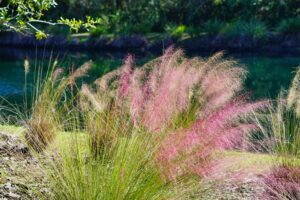
Splitbeard Bluestem (Andropogon ternarius)
A beautiful bunching grass, splitbeard bluestem grass looks a bit like an old man’s white beard when in flower! It can grow up to 4 feet tall and offers a variety of color and interest to any garden. Splitbeard bluestem grass does tend to enjoy drier soils, and can be found in meadows, plains, and prairies. Plus, its seeds are great for birds and other animals looking for a snack in your native garden!
Eastern Bottlebrush Grass (Elymus hystrix)
Native to northern and central Alabama, eastern bottlebrush grass looks a lot like the name suggests; when in bloom, the inflorescence looks a lot like a brush you might use to clean out your reusable water bottle! It grows in dry to moist soils, and is found in forests and riverbanks, as well as along mountain slopes. A great option for native gardens that may endure seasons of drought, eastern bottlebrush grass does not require too much watering.
Pink Muhly Grass (Muhlenbergia capillaris)
Found throughout Alabama, pink muhly grass is a showstopper when it comes to color. Once in bloom, it brightens any space with fine, fluffy pink inflorescence, lasting even through winter! In nature, you will find pink muhly grass in pine woodland forests, prairies, and even along roadsides.
Invasive Plants of Alabama
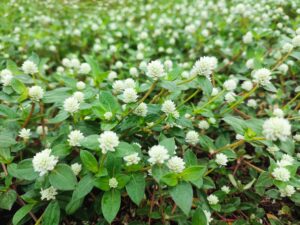
As counterparts to the helpful native plants listed above, invasive plants tend to be a bit more sinister, at least in their non-native habitats. Invasive plants are plants that have been introduced to an area, whether by wind, water, animals, or man. Sometimes, invasive plants are introduced to a landscape by chance, traveling in seed form in the fur of nomadic animals; other times, they’re introduced on purpose, by humans hoping to beautify their gardens!
No matter how they got here, though, invasive plants tend to be harmful to their non-native ecosystem. They typically are able to out-compete native species by brute force, powerful seed-spreading techniques, or even chemical warfare! And worst of all, they tend to cause a decline in biodiversity. As they lower native plant numbers, they also weaken or eradicate native animal populations, as well.
In hopes that you will help lower their numbers, below, we have listed five of Alabama’s worst invasive plant species.
Chinese Privet (Ligustrum sinense)
Often found as an ornamental shrub, Chinese Privet is a very aggressive, thicket-forming shrub. Though it does have attractive fragrant flowers and can fill a space quickly, its invasive nature in the U.S. makes Chinese Privet a poor choice for your home garden. It will surely take over the space, eliminating the chance for other native plants to take root as it spreads quickly via runners and seed-spreading animals.
Japanese Climbing Fern (Lygodium japonicum)
A very interesting plant, Japanese Climbing Fern is exactly what it sounds like: a fern that climbs and twirls around other plants just like a vine! Though it is fascinating, it is also very invasive, easily spreading through entire forests, covering trees, shrubs, and other plants in dense mats. Once established, Japanese Climbing Fern is very difficult to eliminate, its strong stems clinging to and sometimes choking other plants.
Alligator Weed (Alternanthera philoxeroides)
A noxious water weed, alligator weed easily spreads on land and water. It was first reported in Alabama back in 18971, though certainly not considered invasive back then. Interestingly, it’s believed that this invasive, which is native to South America, was introduced through the release of ballast water, or water held in ships to add weight when cargo is limited. Today, alligator weed is a nuisance for kayakers, swimmers, and more, quickly forming mats that lay atop the water. Unfortunately, its negative ecological impacts don’t end with water sports. Alligator weed is also known to clog drainage canals and irrigation lines, restrict oxygen levels and sunlight reach in the water, and out-compete native plants and animals.
Eurasian Watermilfoil (Myriophyllum spicatum)
Another invasive water plant, Eurasian watermilfoil poses many of the same threats as the previous invasive plant discussed above. Requiring still or slightly moving waters, this plant limits the availability of sunlight below its leaves, which crowd the surface; this poses a huge danger to plants and animals that require light to survive, hence, harming the biodiversity of the water. Eurasian watermilfoil grows much more aggressively than its native counterparts, leading to lower numbers of native water plants.
Tropical Soda Apple (Solanum viarum)
Native to Argentina and Brazil, tropical soda apple is a truly interesting looking plant. Its branches contain yellow prickles, its fruit resembles a tiny, cherry tomato-looking watermelon, and its giant leaves look a lot like those of an oak tree! Unfortunately, the tropical soda apple is invasive, so we suggest removing any from your landscape, as long as you watch out for its spiky prickles! Reaching maturity in just over 100 days, its seeds are very easily spread by animals, aiding in its invasive nature.
5 Things You Can Do to Help Alabama’s Native Plants

Alabama’s native plants and trees face threats from climate change, habitat loss, and invasive species. Conservation efforts are underway to protect them. Initiatives include reforestation projects, the establishment of protected areas, and the promotion of sustainable harvesting practices.
But, as a home gardener, you may wonder how you can get involved, how you can help protect Alabama’s native plant population. Well, don’t you worry, because we’ve compiled a list of 5 things you can do to help!
1.Bye bye, Invasive Plants!
As long as you have the right equipment – gloves, soil knives, and pruners – feel free to help the environment by getting rid of invasive plants like the ones listed above!
2. Hello, Native Plants!
Once you remove those pesky invasive plants from your landscape, why not replace them with helpful natives? Visit your local garden center for fully grown specimens or simply start off with seeds, like wild bergamot, goatsbeard, or even pink muhly grass!
3. Welcome Home, Pollinators!
One surefire way to help native plants is to help their pollinators! Refrain from using harmful pesticides in the garden, as they will kill pests as well as pollinators. Plus, you could even purchase things like bee boxes or birdhouses to make pollinators and seed spreaders feel welcome in your space!
4. Natural Fertilizers!
Sometimes, you may want to give your native plants some extra love with fertilizers. However, there’s really no need to drench the earth with harsh chemicals to do so. Instead, try using natural fertilizers like liquid seaweed!
5. Get Involved!
Chances are, if you’re interested in helping out the environment in your neighborhood, others are, as well. So, check out your local parks departments, botanic gardens, and arboretums to see if they’re hosting any volunteer activities. You may find outings to remove invasives from parks, install natives in gardens, or care for city trees! But, of course, sometimes the most important place to start is your own backyard!
Sources:
1.National Invasive Species Information Center.
https://www.invasivespeciesinfo.gov/aquatic/plants/alligatorweed
